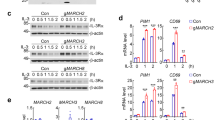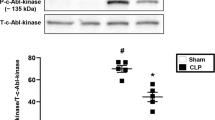Abstract
The E3 ubiquitin ligase Cblb has a crucial role in the prevention of chronic inflammation and autoimmunity. Here we show that Cblb also has an unexpected function in acute lung inflammation. Cblb attenuates the sequestration of inflammatory cells in the lungs after administration of lipopolysaccharide (LPS). In a model of polymicrobial sepsis in which acute lung inflammation depends on the LPS receptor (Toll-like receptor 4, TLR-4), the loss of Cblb expression accentuates acute lung inflammation and reduces survival. Loss of Cblb significantly increases sepsis-induced release of inflammatory cytokines and chemokines. Cblb controls the association between TLR4 and the intracellular adaptor MyD88. Expression of wild-type Cblb, but not expression of a Cblb mutant that lacks E3 ubiquitin ligase function, prevents the activity of a reporter gene for the transcription factor nuclear factor-κB (NF-κB) in monocytes that have been challenged with LPS. The downregulation of TLR4 expression on the cell surface of neutrophils is impaired in the absence of Cblb. Our data reveal that Cblb regulates the TLR4-mediated acute inflammatory response that is induced by sepsis.
This is a preview of subscription content, access via your institution
Access options
Subscribe to this journal
Receive 12 print issues and online access
$209.00 per year
only $17.42 per issue
Buy this article
- Purchase on Springer Link
- Instant access to full article PDF
Prices may be subject to local taxes which are calculated during checkout





Similar content being viewed by others
References
MacCallum, N.S. & Evans, T.W. Epidemiology of acute lung injury. Curr. Opin. Crit. Care 11, 43–49 (2005).
Rubenfeld, G.D. et al. Incidence and outcomes of acute lung injury. N. Engl. J. Med. 353, 1685–1693 (2005).
Levy, H., Laterre, P.F., Bates, B. & Qualy, R.L. Steroid use in PROWESS severe sepsis patients treated with drotrecogin alfa (activated). Crit. Care 9, R502–R507 (2005).
Thien, C.B.F. & Langdon, W.Y. Cbl: Many adaptations to regulate protein tyrosine kinases. Nat. Rev. Mol. Cell Biol. 2, 294–305 (2001).
Levkowitz, G. et al. c-Cbl/Sli-1 regulates endocytic sorting and ubiquitination of the epidermal growth factor receptor. Genes Dev. 12, 3663–3674 (1998).
Yoon, C.H., Lee, J.H., Jongeward, G.D. & Sternberg, P.W. Similarity of Sli-1, a regulator of vulvar development in C. elegans, to the mammalian protooncogene c-cbl. Science 269, 1102–1105 (1995).
Haglund, K. & Dikic, I. Ubiquitylation and cell signaling. EMBO J. 24, 3353–3359 (2005).
Haglund, K. et al. Multiple monoubiquitination of RTKs is sufficient for their endocytosis and degradation. Nat. Cell Biol. 5, 461–466 (2003).
Naramura, M. et al. c-Cbl and Cbl-b regulate T cell responsiveness by promoting ligand-induced TCR down-modulation. Nat. Immunol. 3, 1192–1199 (2002).
Chiang, Y.J. et al. Cbl-b regulates the CD28 dependence of T-cell activation. Nature 403, 216–220 (2000).
Bachmaier, K. et al. Negative regulation of lymphocyte activation and autoimmunity by the molecular adaptor Cbl-b. Nature 403, 211–216 (2000).
Krawczyk, C. et al. Cbl-b is a negative regulator of receptor clustering and raft aggregation in T cells. Immunity 13, 463–473 (2000).
Jeon, M.S. et al. Essential role of the E3 ubiquitin ligase Cbl-b in T cell anergy induction. Immunity 21, 167–177 (2004).
Janeway, C.A. & Medzhitov, R. Innate immune recognition. Annu. Rev. Immunol. 20, 197–216 (2002).
Takeda, K., Kaisho, T. & Akira, S. Toll-like receptors. Annu. Rev. Immunol. 21, 335–376 (2003).
Beutler, B. & Poltorak, A. Sepsis and evolution of the innate immune response. Crit. Care Med. 29, S2–S6 (2001).
Litman, G.W., Anderson, M.K. & Rast, J. Evolution of antigen binding receptors. Annu. Rev. Immunol. 17, 109–147 (1999).
Liew, F.Y., Xu, D.M., Brint, E.K. & O'Neill, L.A.J. Negative regulation of Toll-like receptor-mediated immune responses. Nat. Rev. Immunol. 5, 446–458 (2005).
Keane, M.M., Riverolezcano, O.M., Mitchell, J.A., Robbins, K.C. & Lipkowitz, S. Cloning and characterization of cbl-b—a Sh3 binding-protein with homology to the c-cbl protooncogene. Oncogene 10, 2367–2377 (1995).
Alves-Filho, J.C., de Freitas, A., Russo, M. & Cunha, F.Q. Toll-like receptor 4 signaling leads to neutrophil migration impairment in polymicrobial sepsis. Crit. Care Med. 34, 461–470 (2006).
Naccache, P.H. et al. Agonist-specific tyrosine phosphorylation of Cbl in human neutrophils. J. Leukoc. Biol. 62, 901–910 (1997).
Richards, G.A. The therapeutic challenge of Gram-negative sepsis: Prolonging the lifespan of a scarce resource. Clin. Microbiol. Infect. 11, 18–22 (2005).
Andonegui, G. et al. Endothelium-derived toll-like receptor-4 is the key molecule in LPS-induced neutrophil sequestration into lungs. J. Clin. Invest. 111, 1011–1020 (2003).
Ware, L.B. & Matthay, M.A. The acute respiratory distress syndrome. N. Engl. J. Med. 342, 1334–1349 (2000).
Ankermann, T. et al. Topical inhibition of nuclear factor-kappa B enhances reduction in lung edema by surfactant in a piglet model of airway lavage. Crit. Care Med. 33, 1384–1391 (2005).
Matsuda, N., Hattori, Y., Jesmin, S. & Gando, S. Nuclear factor-kappa B decoy oligodeoxynucleotides prevent acute lung injury in mice with cecal ligation and puncture-induced sepsis. Mol. Pharmacol. 67, 1018–1025 (2005).
Barton, G.M. & Medzhitov, R. Toll-like receptor signaling pathways. Science 300, 1524–1525 (2003).
Ettenberg, S.A. et al. Cbl-b-dependent coordinated degradation of the epidermal growth factor receptor signaling complex. J. Biol. Chem. 276, 27677–27684 (2001).
Ettenberg, S.A. et al. cbl-b inhibits epidermal growth factor receptor signaling. Oncogene 18, 1855–1866 (1999).
Grove, M. & Plumb, M. C/Ebp, NF-κB, and C-Ets family members and transcriptional gegulation of the cell-specific and inducible macrophage inflammatory protein-1α immediate-early gene. Mol. Cell. Biol. 13, 5276–5289 (1993).
Karin, M. & Greten, F.R. NF-κB: linking inflammation and immunity to cancer development and progression. Nat. Rev. Immunol. 5, 749–759 (2005).
Zhou, M.Y. et al. In vivo expression of neutrophil inhibitory factor via gene transfer prevents lipopolysaccharide-induced lung neutrophil infiltration and injury by a β2 integrin-dependent mechanism. J. Clin. Invest. 101, 2427–2437 (1998).
Soubeyran, P., Kowanetz, K., Szymkiewicz, I., Langdon, W.Y. & Dikic, I. Cbl-CIN85-endophilin complex mediates ligand-induced downregulation of EGF receptors. Nature 416, 183–187 (2002).
Yamamoto, M. et al. Role of adaptor TRIF in the MyD88-independent toll-like receptor signaling pathway. Science 301, 640–643 (2003).
Sun, S.C., Ganchi, P.A., Ballard, D.W. & Greene, W.C. NF-κB controls expression of inhibitor IκBα—evidence for an inducible autoregulatory pathway. Science 259, 1912–1915 (1993).
Hoffmann, A., Levchenko, A., Scott, M.L. & Baltimore, D. The IκB-NF-κB signaling module: temporal control and selective gene activation. Science 298, 1241–1245 (2002).
Standiford, T.J. et al. Macrophage inflammatory protein-1α mediates lung leukocyte recruitment, lung capillary leak, and early mortality in murine endotoxemia. J. Immunol. 155, 1515–1524 (1995).
Shanley, T.P., Schmal, H., Friedl, H.P., Jones, M.L. & Ward, P.A. Role of macrophage inflammatory protein-1α (Mip-1α) in acute lung injury in rats. J. Immunol. 154, 4793–4802 (1995).
Gao, J.L. et al. Impaired host defense, hematopoiesis, guanulomatous inflammation and type 1-type 2 cytokine balance in mice lacking CC chemokine receptor 1. J. Exp. Med. 185, 1959–1968 (1997).
Neumann, B. et al. Crucial role of 55-kilodalton TNF receptor in TNF-induced adhesion molecule expression and leukocyte organ infiltration. J. Immunol. 156, 1587–1593 (1996).
Brueckmann, M. et al. Drotrecogin alfa (activated) inhibits NF-kappa B activation and MIP-1-alpha release from isolated mononuclear cells of patients with severe sepsis. Inflamm. Res. 53, 528–533 (2004).
Kobayashi, K. et al. IRAK-M is a negative regulator of toll-like receptor signaling. Cell 110, 191–202 (2002).
Deng, J.C. et al. Sepsis-induced suppression of lung innate immunity is mediated by IRAK-M. J. Clin. Invest. 116, 2532–2542 (2006).
Chuang, T.H. & Ulevitch, R.J. Triad3A, an E3 ubiquitin-protein ligase regulating Toll-like receptors. Nat. Immunol. 5, 495–502 (2004).
Iwata, A. et al. Over-expression of Bcl-2 provides protection in septic mice by a trans effect. J. Immunol. 171, 3136–3141 (2003).
Hickey, M.J. et al. Inducible nitric oxide synthase (iNOS) in endotoxemia: chimeric mice reveal different cellular sources in various tissues. FASEB J. 16, 1141–1143 (2002).
Tiruppathi, C. et al. Impairment of store-operated Ca2+ entry in TRPC4−/− mice interferes with increase in lung microvascular permeability. Circ. Res. 91, 70–76 (2002).
Blackwell, T.S. et al. Multiorgan nuclear factor kappa B activation in a transgenic mouse model of systemic inflammation. Am. J. Respir. Crit. Care Med. 162, 1095–1101 (2000).
Bosco, M.C. et al. The tryptophan catabolite picolinic acid selectively induces the chemokines macrophage inflammatory protein-1 alpha and -1 beta in macrophages. J. Immunol. 164, 3283–3291 (2000).
Melkonyan, H., Sorg, C. & Klempt, M. Electroporation efficiency in mammalian cells is increased by dimethyl sulfoxide (DMSO). Nucleic Acids Res. 24, 4356–4357 (1996).
Acknowledgements
We thank L.A. Benoit and K. Wary for discussions, K. Price for critical reading of the manuscript, Y. Wu for technical assistance, and S. Lipkowitz of the US National Cancer Institute for Cblb expression vector constructs. This work was supported by US National Institutes of Health grants P01 HL77806, PO1 HL60678 and T32 HL 07829.
Author information
Authors and Affiliations
Corresponding author
Ethics declarations
Competing interests
The authors declare no competing financial interests.
Rights and permissions
About this article
Cite this article
Bachmaier, K., Toya, S., Gao, X. et al. E3 ubiquitin ligase Cblb regulates the acute inflammatory response underlying lung injury. Nat Med 13, 920–926 (2007). https://doi.org/10.1038/nm1607
Received:
Accepted:
Published:
Issue Date:
DOI: https://doi.org/10.1038/nm1607
This article is cited by
-
Tea Polyphenols Reduce Inflammation of Orbital Fibroblasts in Graves’ Ophthalmopathy via the NF-κB/NLRP3 Pathway
Current Medical Science (2023)
-
The RING finger protein family in health and disease
Signal Transduction and Targeted Therapy (2022)
-
Long non-coding RNA OIP5-AS1 aggravates acute lung injury by promoting inflammation and cell apoptosis via regulating the miR-26a-5p/TLR4 axis
BMC Pulmonary Medicine (2021)
-
E3 ubiquitin ligase RNF128 promotes innate antiviral immunity through K63-linked ubiquitination of TBK1
Nature Immunology (2016)
-
The p110δ isoform of the kinase PI(3)K controls the subcellular compartmentalization of TLR4 signaling and protects from endotoxic shock
Nature Immunology (2012)



